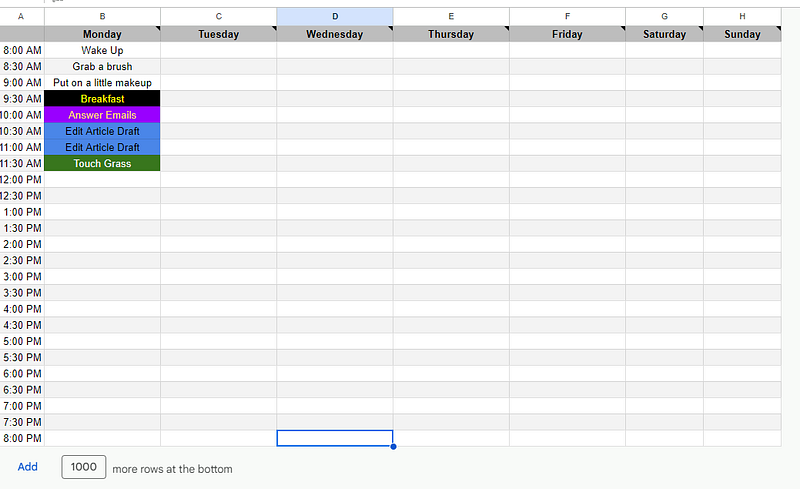The ADHD Guide to Freelancing
Having a functional career is kinda hard these days, especially if you’re a person of a creative bent. With the double whammy of companies…

Having a functional career is kinda hard these days, especially if you’re a person of a creative bent. With the double whammy of companies laying off large chunks of their workforce and putting up higher barriers to hiring, many of us have either opted or been forced into offering our services as freelancers.
This isn’t to say that freelancing is bad, or in any way inferior to working the corporate world, 9–5 or whatever your hours may be. But it is a different experience, one in which the guardrails all come down, allowing us great freedom. A freelancer can set their own terms — we can sleep in till 10, work all day in pajamas, or haunt the local coffee shop, a half-full cup of cold coffee at our side like a talisman to ward off the anxiety and stigma of being expected to spend money to occupy space…
Ahem, that got away from me a bit.
But freedom is power, and with power must come responsibility. We’re responsible for every aspect of our business: communication, documentation, marketing, invoices, taxes….and that’s just the admin! Throw in the increasingly likely chance that you’re doing more than one type of freelance work, and all of that multiplies. It’s enough to overwhelm anyone, and is particularly difficult for people with certain flavors of neurodivergence.
As a freelancer with ADHD, I have experienced the difficulty of juggling all the needs of managing one’s own business, and the pitfalls that can be hard to see while keeping your eyes on everything up in the air. But what if I told you there was help? What if I said there are ways, not only to mitigate the struggles of neurodivergent freelancing, but to turn the ways your brain works differently to your advantage in the field?
I’d say, “stop blathering and show me already!”
Okay, okay, I get it. Please allow me to present:
The ADHD Guide to Freelancing
First of all, a disclaimer: This is a collection of tips and recomendations, based entirely on my own experience with ADHD and freelancing. No two brains work exactly the same, and no bit of advice will perfectly suit everyone — as the saying goes, your mileage may vary.
1. Start your workday with a clear head
One of the most disruptive forces in our lives is the firehose of information (good and bad) we have access to at all times. This is doubly true in the era of smartphones. Consider for a moment, the first thing you do when you wake up in the morning. Do you reach over, pluck your phone from its charger and turn off the alarm, only to immediately open your favorite social media app? I know I have — and far too often, I’ve found myself delaying the start to my day, overindulging on videos of cute animals, or feverishly scrolling through posts to digest the day’s news.
Inevitably, I would find that I’d sabotaged the start of my day — either behind schedule, attention split over too many things, or my calm disturbed by some negative news article. So one day, I decided to replace this habit. Instead of spending my morning on my phone, I developed a ritual of sorts to start my day. Now, when I say ritual, I don’t mean sprinkling salt all over the ground and chanting in latin while wearing a hooded cloak (though if that works for you, go nuts). No, I mean find a set of things that eases you into the day. Generally, this should always include some kind of (hopefully) healthy, easy-to-make breakfast — I usually aim for yogurt or oatmeal, but sometimes a comfort pop tart works too. Then, I brew myself a cup of coffee, and sit on the couch (NOT my work desk) and put on a calming music playlist while I wake up. On most days, my ritual takes about 30–40 minutes, but I give myself about an hour when I need it. Throughout, I keep my phone just out of reach (Or in another room if I’m really tempted to check it), and when I get up, I’m ready to take on the day.
2. Use the Pomodoro Technique — with some tweaks
The Pomodoro Technique is a time management method, named after those silly kitchen timers that everyone’s grandma had in the 80’s. The basic idea behind it is to set a timer (roughly 30 mins to 1 hour), pick a specific task, and work only on that task for the set time. When it goes off, you set the timer again, but this time for a short period (5–10 minutes, typically), during which you give yourself downtime. Pretty simple, no?
For those of us with ADHD, the pomodoro technique can be amazing: By committing to working on something for a set time, we push our brains into shutting out distractions easier (though it still takes practice to limit them completely), and makes it easier to slip into a productive flow state. However, there are some problems…
Sometimes, we’re not just focused, we’re hyperfocused. When that happens, it can be annoying, or downright frustrating to have a noisy timer ripping us away from our task at hand. Luckily, this technique is versatile! Just take a look at HowToADHD’s 3 minute video on the Pomodoro and how to use one with an ADHD brain:
Personally, I find it best to treat the timer as a suggestion, rather than a hard demand to take a break. If I’m engrossed in a task and don’t want to be bothered, I simply reset the timer, or set a secondary one, like hitting snooze on an alarm. That way, I can continue my work without going too long and risking burnout.
3. Track (or plan) your productive time visually
If you’re freelancing, you’re most likely billing by the hour. But even if you’re not (project-based rates are a thing as well), it can be helpful to know how much time you’re spending on your work, not to mention finding time for yourself. But how to do this without resorting to tedious time-card punching? My answer is, using a block schedule to plan or track time.
A block schedule is pretty loosely defined, but basically involves breaking up your day into a set of ‘blocks’, and dedicating those blocks to different tasks or groups of similar tasks, like a roughly scheduled to-do list. Commonly, this is as simple as two blocks of four hours each, one dedicated to work, and another to chores, errands, exercise, etc.
But there’s another way to use a block schedule: As a time-tracking template! In my version, I start with a spreadsheet formatted for half-hour blocks over a general week, like so:

At the start of each week, I fill out the days of the month in the template, and block out any time slots for pre-scheduled activities (client meetings, social outings, doctor appointments, etc), and keep the sheet open on my computer throughout the day. Along with the pomodoro technique, this sheet makes it very easy to track how I’ve spent my day — and to calculate hours spent on different projects, noting when I’ve been working too long and need a break, as well as looking at my own work trends in the long term. Most importantly, it has a hard cut-off of 8:00 PM (though you may wish to set it earlier), so I don’t regularly allow myself to work too late into a given evening.
4. Take breaks & let yourself play
All work and no play makes everyone a dull person! This one is obvious to some, but if you’re the type of person who can easily fixate on a task (or multiple tasks), it can be hard to pull yourself out of that and enjoy your hobbies. This goes doubly so for us freelancers — all too often we fall prey to feelings of guilt when we aren’t spending time meeting a deadline, or following our marketing and client outreach plan.
In conjunction with the pomodoro technique and block scheduling, it is essential to give yourself some time (whether evenings, mornings, an entire day or weekend, etc.) to relax and engage in your non-monetized hobbies and passions. And if you aren’t sure what those are, give yourself time to explore some! I personally reccomend hobbies that keep you away from your workstation (for example, nature walks for those who work on a computer), so there’s little chance of sliding back into working when you should be relaxing.
5. Socialize to break up isolation
When you are working for yourself, especially in a creative capacity, it is very easy to become isolated. Working from home has many great benefits, but compounding loneliness is not one of them. Instead, take your work elsewhere (if possible) — to a coffee shop, a friend’s house, or a public park. Join interest or professional groups for your industry, and participate as much as you can, in person or online. Keep touch with friends, even if you need to do it over social media.
Set aside the time to socialize, or even ‘network’ a bit each day. In the long run, your quality of work and quality of life will be far better for it.
These are some things that have helped me to balance my time as a freelancer, but they are by no means the only ways to do so! I hope you find them helpful, whether you’re considering a side business, knee-deep in the freelancing world already, or at a loss for where to start. Have any other tips, advice or suggestions? I’d love to hear them — leave a comment below!
